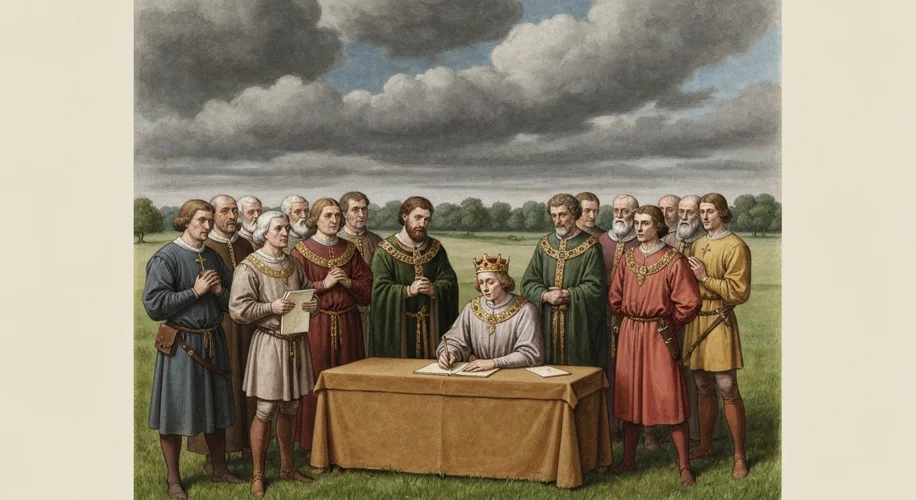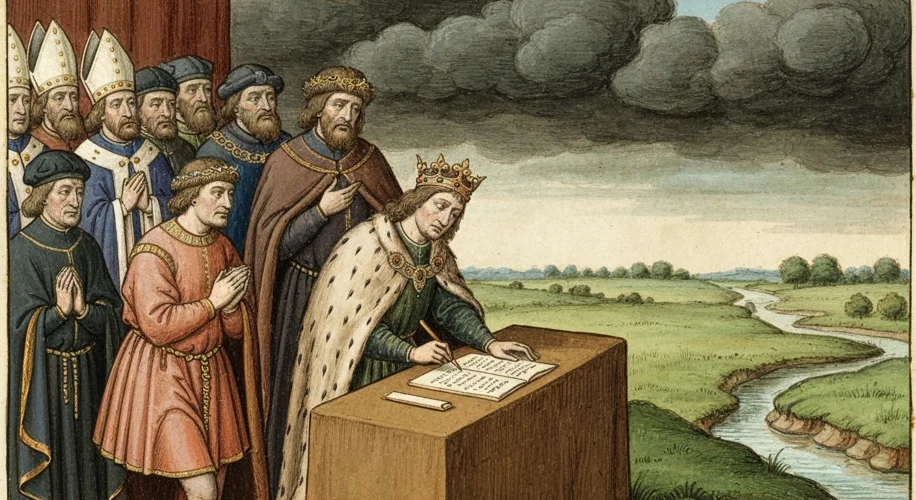The year is 1215. England is a powder keg, simmering with discontent. King John, a monarch whose reign had been marked by disastrous foreign policies, crippling taxes, and a contemptuous disregard for the rights of his barons, found himself cornered. His coffers were empty, his authority challenged, and a formidable army of rebellious barons stood ready to depose him.
On a damp June day, by the banks of the River Thames at Runnymede, a tense standoff was set to change the course of history. This was not a battle fought with swords and shields, but with ink and parchment. Here, under duress, King John affixed his seal to a document that would echo through the centuries: the Magna Carta, or the Great Charter.

The background to this pivotal moment was steeped in the feudal system, where the king was theoretically absolute, but in practice relied on the loyalty and support of his powerful barons. However, John’s incessant demands for funds to fight costly wars in France, coupled with his arbitrary judgments and infringements on feudal customs, had pushed these powerful men to their breaking point. They saw their traditional rights and privileges being eroded, and they were no longer willing to tolerate it.
Among the key figures were the barons themselves, a collection of influential nobles like Robert Fitzwalter, who led the rebellion, and Archbishop Stephen Langton, a key mediator who played a crucial role in drafting the charter. King John, of course, was the central figure, a monarch often depicted as capricious and untrustworthy. His perspective was that of a king trying to assert his authority and secure his kingdom, often at the expense of his subjects’ liberties.
The Magna Carta itself was not a radical declaration of universal human rights as we might understand them today. It was, at its heart, a peace treaty, a set of concessions wrested from a beleaguered king by his most powerful subjects. It contained 63 clauses, many of which dealt with specific feudal grievances, such as inheritance rights, wardship, and the regulation of royal forests. However, embedded within these clauses were principles that would prove revolutionary.
Perhaps the most famous clauses, 39 and 40, declared that no free man could be imprisoned, outlawed, exiled, or deprived of his possessions “except by the lawful judgment of his equals or by the law of the land,” and that “to no one will we sell, to no one deny or delay right or justice.”
These words, born out of a specific medieval dispute, laid the groundwork for the concept of due process and the rule of law, asserting that even the king was subject to the law. This was a radical departure from the idea of absolute monarchy.
The immediate impact of the Magna Carta was limited. King John, with the Pope’s backing, quickly repudiated it, leading to the First Barons’ War. However, after John’s death in 1216, the charter was reissued, with modifications, by his young son Henry III. Over the following decades, it was confirmed and reconfirmed by successive monarchs, becoming a cornerstone of English law.
The long-term consequences of the Magna Carta were profound. It established the principle that government power is not absolute and that individuals possess certain rights that cannot be arbitrarily infringed. It inspired future generations of reformers and revolutionaries, influencing the development of constitutional law in Britain and across the globe, including the American Declaration of Independence and the Bill of Rights.
While the Magna Carta was a product of its time, a document forged in the crucible of medieval power struggles, its enduring legacy lies in its fundamental assertion of liberty against tyranny. It stands as a powerful testament to the idea that even the most powerful ruler can be held accountable, a beacon of hope for those seeking justice and freedom, reminding us that the struggle for rights is a continuous, evolving narrative.

